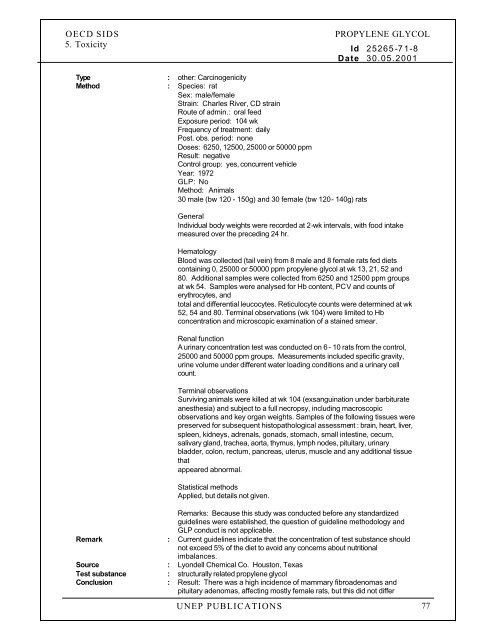Dipropylene glycol (SIDS)
Dipropylene glycol (SIDS)
Dipropylene glycol (SIDS)
Create successful ePaper yourself
Turn your PDF publications into a flip-book with our unique Google optimized e-Paper software.
OECD <strong>SIDS</strong> PROPYLENE GLYCOL<br />
5. Toxicity<br />
Id 25265-71-8<br />
Date 30.05.2001<br />
Type : other: Carcinogenicity<br />
Method : Species: rat<br />
Sex: male/female<br />
Strain: Charles River, CD strain<br />
Route of admin.: oral feed<br />
Exposure period: 104 wk<br />
Frequency of treatment: daily<br />
Post. obs. period: none<br />
Doses: 6250, 12500, 25000 or 50000 ppm<br />
Result: negative<br />
Control group: yes, concurrent vehicle<br />
Year: 1972<br />
GLP: No<br />
Method: Animals<br />
30 male (bw 120 - 150g) and 30 female (bw 120 - 140g) rats<br />
General<br />
Individual body weights were recorded at 2-wk intervals, with food intake<br />
measured over the preceding 24 hr.<br />
Hematology<br />
Blood was collected (tail vein) from 8 male and 8 female rats fed diets<br />
containing 0, 25000 or 50000 ppm propylene <strong>glycol</strong> at wk 13, 21, 52 and<br />
80. Additional samples were collected from 6250 and 12500 ppm groups<br />
at wk 54. Samples were analysed for Hb content, PCV and counts of<br />
erythrocytes, and<br />
total and differential leucocytes. Reticulocyte counts were determined at wk<br />
52, 54 and 80. Terminal observations (wk 104) were limited to Hb<br />
concentration and microscopic examination of a stained smear.<br />
Renal function<br />
A urinary concentration test was conducted on 6 - 10 rats from the control,<br />
25000 and 50000 ppm groups. Measurements included specific gravity,<br />
urine volume under different water loading conditions and a urinary cell<br />
count.<br />
Terminal observations<br />
Surviving animals were killed at wk 104 (exsanguination under barbiturate<br />
anesthesia) and subject to a full necropsy, including macroscopic<br />
observations and key organ weights. Samples of the following tissues were<br />
preserved for subsequent histopathological assessment : brain, heart, liver,<br />
spleen, kidneys, adrenals, gonads, stomach, small intestine, cecum,<br />
salivary gland, trachea, aorta, thymus, lymph nodes, pituitary, urinary<br />
bladder, colon, rectum, pancreas, uterus, muscle and any additional tissue<br />
that<br />
appeared abnormal.<br />
Statistical methods<br />
Applied, but details not given.<br />
Remarks: Because this study was conducted before any standardized<br />
guidelines were established, the question of guideline methodology and<br />
GLP conduct is not applicable.<br />
Remark : Current guidelines indicate that the concentration of test substance should<br />
not exceed 5% of the diet to avoid any concerns about nutritional<br />
imbalances.<br />
Source : Lyondell Chemical Co. Houston, Texas<br />
Test substance : structurally related propylene <strong>glycol</strong><br />
Conclusion : Result: There was a high incidence of mammary fibroadenomas and<br />
pituitary adenomas, affecting mostly female rats, but this did not differ<br />
UNEP PUBLICATIONS 77
















